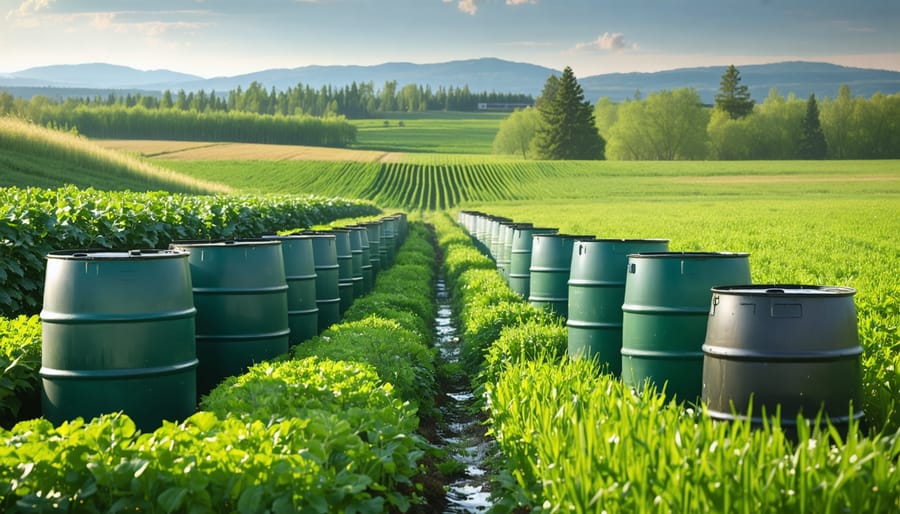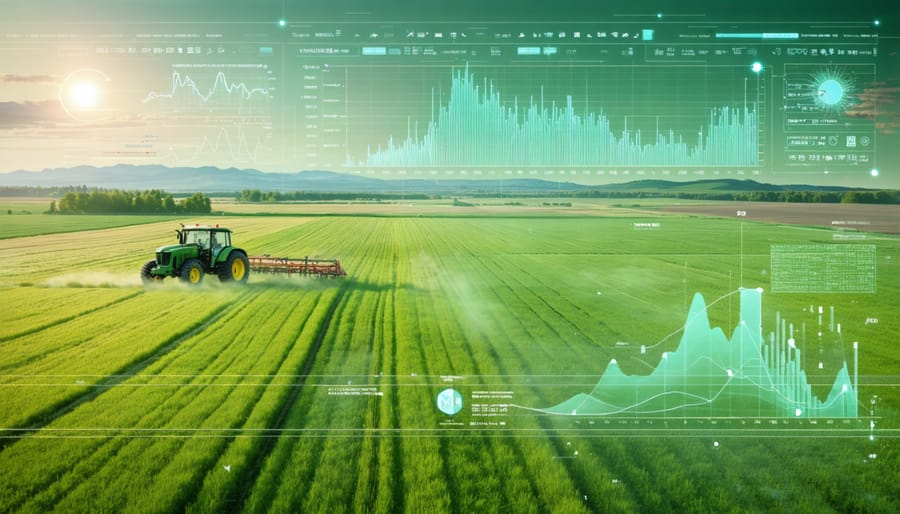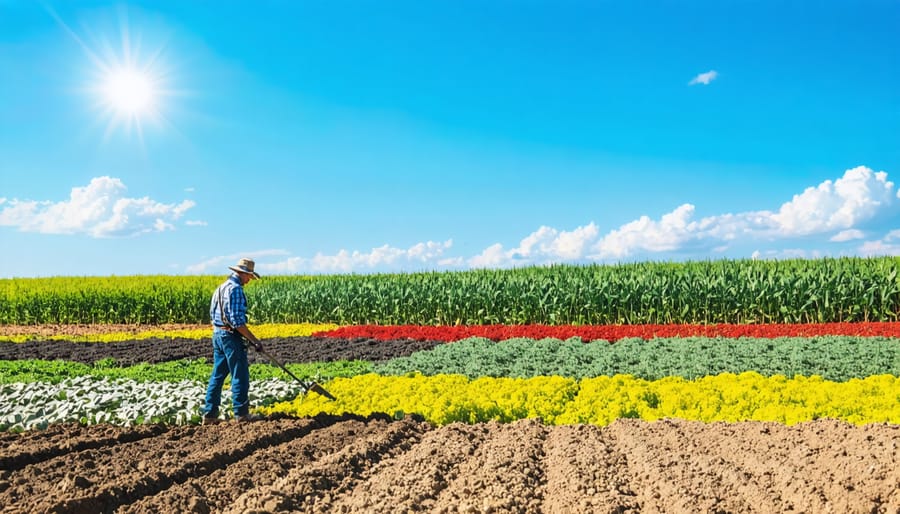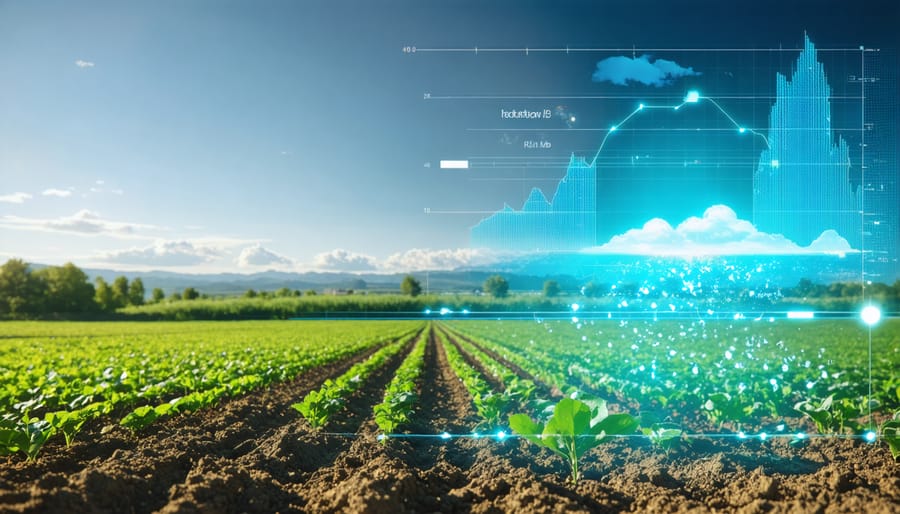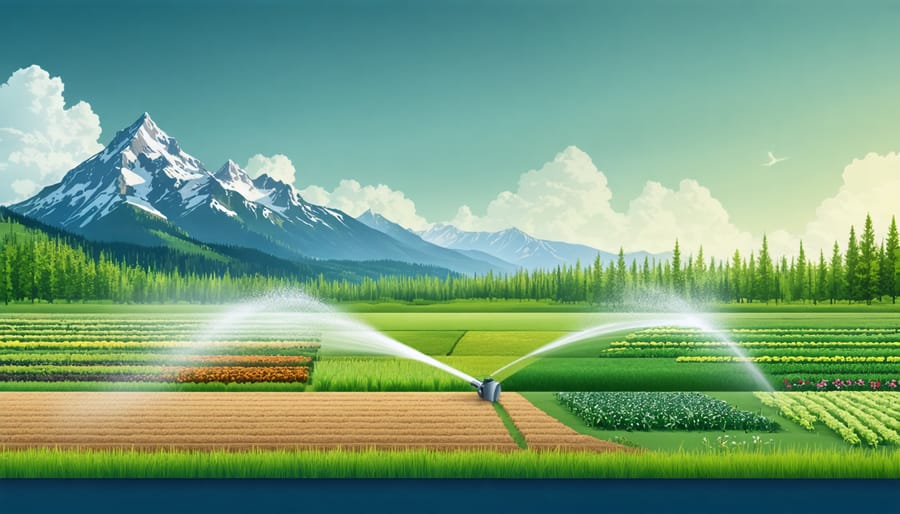Transform your farm’s water security by capturing Alberta’s precious rainfall – a sustainable solution that’s revolutionizing irrigation practices across the prairie provinces. Every millimetre of rain that falls on your property represents a valuable resource, with just 25mm of rainfall on a 100-square-metre roof yielding 2,500 litres of usable water.
Alberta farmers are increasingly turning to rainwater harvesting systems, not just as a drought-resilience strategy, but as a cost-effective way to reduce dependence on municipal water supplies and deep wells. From simple barrel collection systems to sophisticated underground cisterns, these systems can provide up to 40% of a farm’s irrigation needs during the critical growing season.
Modern rainwater harvesting combines time-tested principles with cutting-edge technology, allowing farmers to maintain crop yields even during dry spells while significantly reducing their water bills. Real-world success stories from Lethbridge to Red Deer demonstrate how these systems pay for themselves within 2-5 growing seasons through reduced water costs and improved crop resilience.
Start your journey toward water independence today by exploring the proven collection methods, storage solutions, and distribution systems that best suit your farm’s unique needs.
Why Rainwater Harvesting Makes Sense in Alberta
Alberta’s Rainfall Patterns and Agricultural Needs
Alberta’s annual precipitation patterns present both challenges and opportunities for agricultural operations. The province typically receives between 300-500mm of annual rainfall, with approximately 70% occurring during the crucial growing season between May and August. However, these patterns are becoming increasingly unpredictable, making it essential for farmers to implement effective water management strategies to ensure consistent crop yields.
Most Alberta crops require 400-600mm of water throughout the growing season, creating a potential deficit that traditional irrigation systems alone may struggle to meet. This gap is particularly noticeable in regions like Southern Alberta, where semi-arid conditions prevail. The timing of rainfall is just as crucial as the amount – late spring and early summer moisture is essential for establishing crops, while August precipitation significantly impacts yield quality.
By understanding these patterns, farmers can better plan their rainwater harvesting systems to capture and store moisture when it’s most abundant, typically during June and July’s heavy rainfall events. This stored water becomes invaluable during dry spells and helps reduce dependence on groundwater and municipal sources.
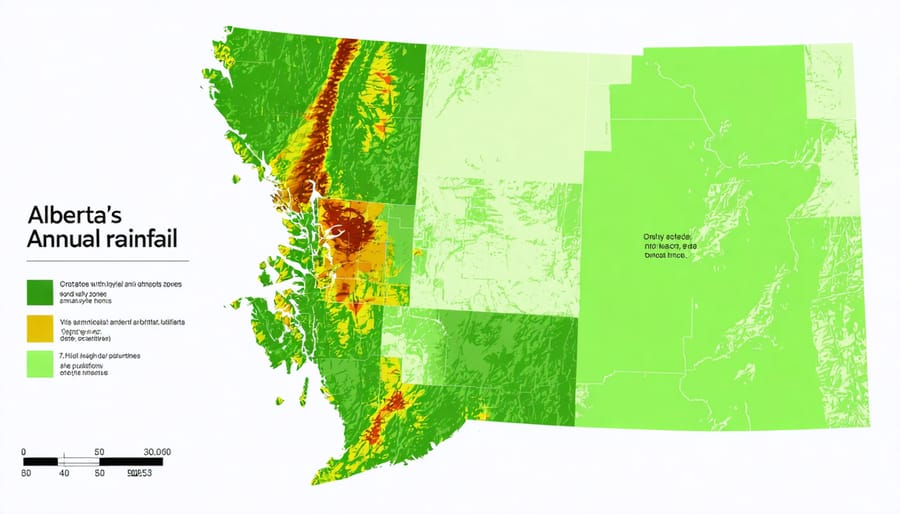
Cost-Benefit Analysis for Farm Operations
Based on data from Alberta farms, a typical 1,000-square-metre rainwater harvesting system costs between $15,000 and $25,000 to install. While this initial investment may seem substantial, most farmers report breaking even within 3-5 years through reduced water costs and increased crop yields.
A case study from a Red Deer County farm showed annual water savings of 750,000 litres, translating to approximately $2,000 in reduced utility costs. Their system, installed in 2019, paid for itself in just over 4 years when factoring in government rebates and tax incentives available to Alberta farmers.
The financial benefits extend beyond direct water savings. Farmers report 15-20% increases in crop yields due to more consistent irrigation, particularly during dry spells. Additional benefits include reduced soil erosion and lower fertilizer costs, as rainwater contains natural nutrients.
Maintenance costs average $200-400 annually, primarily for filter replacement and system inspection. When properly maintained, these systems typically last 20-25 years, making them a sound long-term investment for Canadian farming operations.
Essential Harvesting Systems for Alberta Farms
Surface Runoff Collection Systems
Surface runoff collection systems in Alberta need to work harmoniously with existing soil and water conservation practices to maximize efficiency. The most effective collection method for our climate involves strategically placed berms and swales that direct water flow toward collection points.
For small to medium operations, installing gutters along existing structures like barns and equipment sheds provides an excellent starting point. These systems typically use standard eavestrough configurations with downspouts leading to storage tanks. For larger operations, ground-level collection areas can be created using gentle slopes (typically 2-3%) that guide water toward centralized collection basins.
Many Alberta farmers have found success with French drains – gravel-filled trenches with perforated pipes that capture and direct surface water. These systems work particularly well in our prairie landscape and can handle both spring melt and summer storm events.
Collection surfaces should be kept clean and free from debris, with first-flush diverters installed to prevent contamination. For every 100 square metres of collection area, you can expect to harvest about 1,000 litres of water from a 10mm rainfall event. This calculation helps in planning storage capacity based on your specific needs and local precipitation patterns.
Remember to include sediment traps and filters at collection points to maintain water quality for irrigation purposes. These systems require minimal maintenance but should be inspected regularly, especially after major weather events.
Rooftop Collection Solutions
Farm buildings provide an excellent opportunity for efficient rainwater collection in Alberta. Modern rooftop water collection systems can transform your existing structures into valuable water-gathering assets. A typical barn roof of 200 square metres can collect approximately 150,000 litres of water annually in our region, based on average precipitation patterns.
To maximize collection efficiency, consider the roof’s material and condition. Metal roofs are ideal, offering clean runoff and durability, while asphalt shingles require additional filtration. Many Alberta farmers have found success with simple gutter systems connected to downspouts that direct water into storage tanks.
The Robertson family farm near Red Deer demonstrates the potential of building-based collection. By retrofitting their machinery shed and barn with professional-grade gutters and first-flush diverters, they now collect enough water to irrigate their 2-hectare market garden throughout the growing season.
Key considerations for your roof collection system include:
– Snow load capacity of existing structures
– Gutter size and placement for maximum capture
– Debris management systems
– First-flush diverters for initial rainfall
– Strategic downspout positioning
Remember to regularly inspect and clean your gutters, particularly after winter, to ensure optimal performance. Many local contractors specialize in agricultural rainwater harvesting installations and can help design a system that meets your specific needs.
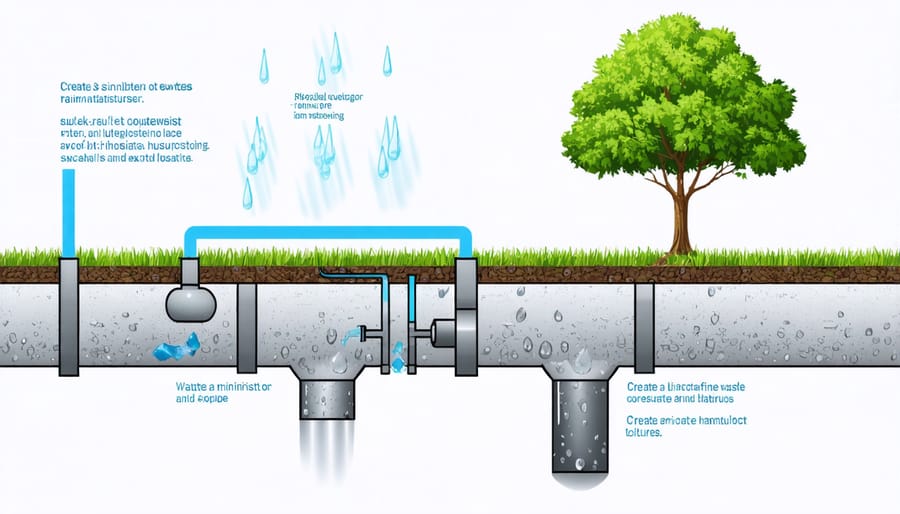
Storage Options and Considerations
In Alberta’s varied climate, choosing the right storage solution for your harvested rainwater is crucial for successful irrigation. Above-ground tanks, typically ranging from 1,000 to 10,000 litres, are popular among smaller operations due to their easy installation and maintenance. These tanks work well for greenhouse operations and market gardens, though they require insulation for winter use.
Underground cisterns, while more expensive initially, offer excellent protection against freezing and maintain consistent water temperatures. Many Alberta farmers find these ideal for larger operations, with capacities often exceeding 50,000 litres. They’re particularly valuable in areas experiencing extreme temperature fluctuations.
Farm ponds and dugouts represent a traditional approach still widely used across the province. These natural-looking options can store massive volumes of water and double as wildlife habitats. However, they require proper lining to prevent seepage and regular maintenance to manage algae growth.
When selecting your storage solution, consider factors like your irrigation needs, available space, and budget. For example, the Thomson Family Farm near Red Deer successfully combines a 30,000-litre underground cistern with several above-ground tanks, maximizing storage capacity while maintaining year-round accessibility.
Remember to account for overflow management and ensure your system includes appropriate filtration. Many Alberta farmers also incorporate first-flush diverters to maintain water quality, especially important for certified organic operations.
Implementation Success Stories
Small-Scale Success: The Jensen Family Farm
Located just outside of Olds, Alberta, the Jensen Family Farm has become a shining example of proven rainwater harvesting results in small-scale agriculture. Sarah and Tom Jensen transformed their 40-hectare mixed farming operation by implementing a comprehensive rainwater collection system in 2019.
The Jensens installed six 5,000-litre storage tanks connected to their barn and greenhouse roofs, capturing approximately 150,000 litres of rainwater annually. Their system includes first-flush diverters, mesh filters, and UV treatment to ensure water quality for their organic vegetable production.
The initial investment of $12,000 was recovered within two years through reduced municipal water costs and increased crop yields. Their sophisticated drip irrigation system, fed by gravity from elevated storage tanks, has reduced their water consumption by 40% compared to their previous practices.
“We used to worry about water restrictions during dry spells,” says Sarah Jensen. “Now we can irrigate our greenhouse crops year-round and maintain consistent soil moisture in our field vegetables, even during challenging growing seasons.”
The Jensens regularly host farm tours for local agricultural groups, sharing their experience and encouraging others to consider rainwater harvesting as a viable solution for small-scale farming operations in Alberta’s variable climate.
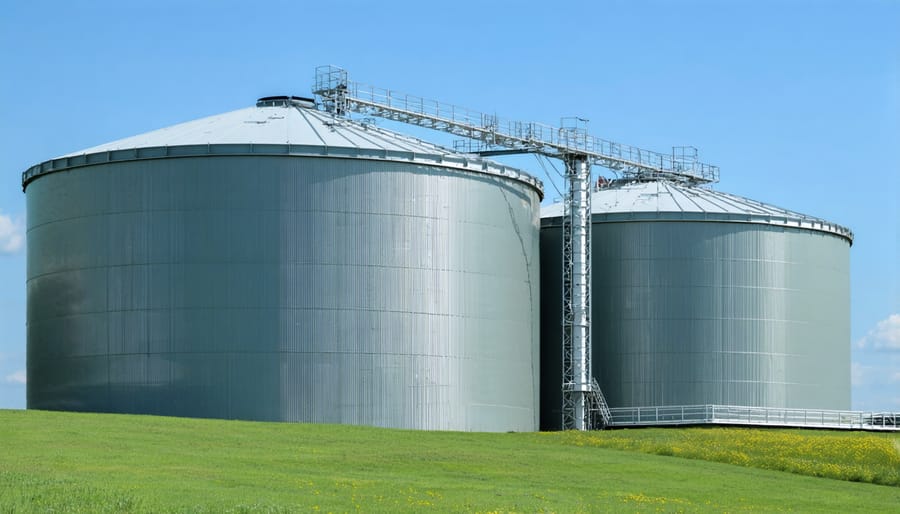
Large Operation Integration: Prairie Vista Farms
Prairie Vista Farms in Red Deer County stands as a shining example of successful large-scale rainwater harvesting implementation in Alberta. In 2019, owner Sarah MacKenzie invested in a comprehensive system that now captures runoff from 4,000 square metres of roof area across multiple farm buildings.
The system includes three interconnected storage tanks with a total capacity of 450,000 litres, supplying irrigation for 16 hectares of mixed vegetables and greenhouse operations. During the challenging drought of 2021, the farm maintained 85% of its typical crop yield while neighbouring properties struggled with significant losses.
“The system paid for itself within two growing seasons,” explains MacKenzie. “We’ve reduced our reliance on municipal water by 70% and saved approximately $12,000 annually in water costs.” The installation, which cost $75,000, qualified for a $30,000 grant through the Canadian Agricultural Partnership program.
The farm’s success has inspired fifteen other local operations to implement similar systems. MacKenzie hosts monthly workshops showing farmers how to scale rainwater harvesting to their specific needs. The system includes UV filtration and automated distribution controls, maintaining water quality while minimizing labour requirements.
Particularly noteworthy is the farm’s innovative approach to winter management, using underground storage and heating elements to prevent freezing, ensuring year-round greenhouse operation even during Alberta’s coldest months.
Maintenance and Winter Considerations
Year-Round Maintenance Schedule
To keep your rainwater harvesting system operating efficiently throughout Alberta’s varied seasons, follow these monthly maintenance tasks:
Spring (March-May):
– Clean gutters and downspouts of winter debris
– Inspect collection tanks for winter damage
– Clean or replace filters
– Check seals and connections
– Test pump functionality after winter
Summer (June-August):
– Monitor mosquito screening
– Check water quality monthly
– Clear debris from collection surfaces
– Inspect overflow mechanisms
– Clean first-flush diverters
Fall (September-November):
– Remove leaves from gutters regularly
– Prepare system for winter
– Drain exposed pipes
– Clean and sanitize storage tanks
– Check insulation
Winter (December-February):
– Monitor ice buildup
– Ensure heated components are functioning
– Clear snow from collection areas
– Check tank levels
– Inspect indoor components
Monthly Year-Round:
– Test water quality
– Check pump operation
– Clear debris from screens
– Inspect for leaks
– Document system performance
Remember to maintain detailed records of all maintenance activities and system performance. For systems larger than 10,000 litres, consider scheduling professional inspections twice yearly.
Winterizing Your System
In Alberta’s harsh winters, protecting your rainwater harvesting system from freeze damage is crucial. Start by draining all above-ground pipes, tanks, and filters completely before the first frost, typically in late October. Use compressed air to blow out any remaining water from the lines – even small amounts can cause pipe bursts when frozen.
For underground components, ensure they’re buried below the frost line (minimum 2.1 metres in most parts of Alberta). If you have above-ground storage tanks, either empty them completely or maintain them at 40% capacity with proper insulation. This prevents structural damage from ice expansion while providing enough thermal mass to resist freezing.
Disconnect and store pumps indoors, and remove or protect filters and UV systems. For gutters and downspouts, install heat cables if you plan to collect snowmelt during winter thaws. Cover tank openings and vents with insulated caps, but don’t seal them completely – proper ventilation prevents pressure buildup.
Consider installing a backup power source for heating elements if you’re maintaining an active system through winter. Document your winterizing process and set reminders for spring reactivation to ensure nothing is overlooked.
Embracing rainwater harvesting for irrigation represents a significant step toward sustainable agriculture in Alberta. Throughout this guide, we’ve explored the numerous benefits of these systems, from reducing water costs to enhancing crop resilience during dry periods. The success stories of local farmers demonstrate that with proper planning and implementation, rainwater harvesting can be both environmentally and economically rewarding.
Remember that you’re not alone in this journey. Alberta’s agricultural community offers numerous resources and support networks to help you get started. Your local agricultural extension office can provide detailed guidance on system design and implementation, while various government programs offer financial assistance for sustainable farming initiatives.
Start small if needed – even a basic collection system can make a meaningful difference. Consider connecting with neighbouring farms that have successfully implemented rainwater harvesting systems. Their practical experience and insights can prove invaluable as you develop your own approach.
As climate patterns continue to evolve, investing in rainwater harvesting isn’t just about current benefits – it’s about building a resilient future for Alberta’s agricultural sector. Whether you’re managing a small family farm or overseeing larger operations, the tools and knowledge are available to make rainwater harvesting work for your specific needs.
Take that first step today. Assess your property, connect with local resources, and begin planning your rainwater harvesting system. Your efforts will contribute to both the sustainability of your farm and the broader environmental stewardship of our agricultural community.

